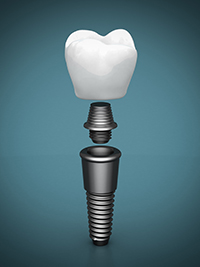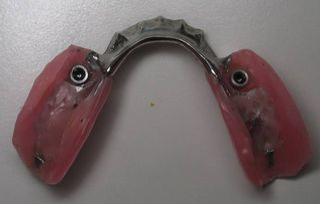What are dental implants?
If you are missing one or more teeth, the best replacements are dental implants. You may have heard about dental implants, but don’t really know what they are or still have questions about them. Dental implants are placed by professionals for several reasons. You may have heard of a crown, or cap, to cover and replace the part of the tooth you see when you smile, the crown. A dental implant replaces the part of the tooth that is in your jawbone, the tooth root. There are several different types of dental implants, so a comprehensive treatment plan and x-ray diagnostics are required prior to treatment.
Dental implants can replace a single tooth. This is the most common dental implant replacement.
You can basically think of a dental implant as a screw that is placed in your jaw and is cemented permanently in place. We call this part of the complete implant complex the implant body. There are different kinds and shapes of connectors that can be placed on top of the implant body, called abutments. An implant abutment, or connector, allows a laboratory made tooth, or crown, to be cemented to the implant body.
Another way Tooth Implants can replace missing teeth is by connecting more than one tooth to an implant body (remember, that’s the screw portion of the whole thing). If you’re missing a few teeth all in a row, Dr. Van de Vyver can place a couple implants in the area and cement multiple teeth on them. If you know what a dental bridge is, then this is the same thing. The only difference is that instead of being cemented on natural teeth, the bridge is cemented on top of implants. An implant supported bridge is an excellent replacement for multiple missing teeth.
A different way to put multiple teeth on implants is with an implant supported partial denture. I’m sure you’ve seen a partial denture before, a horseshoe shaped piece of metal with plastic teeth and metal hooks on it? Well, instead of metal hooks that hold onto natural teeth, an implant supported partial denture has connectors on the inside that snap onto implant abutments. With the partial now snapping onto implants, it doesn’t move around when you talk and eat. An implant supported partial denture is a great alternative to a traditional partial.
Even if you’re missing all of your teeth, dental implants may still be a great treatment option for you. Two, four, or more implants can be placed along the arch of your jawbone and a full denture (sometimes patients call them “plates”) can snap into place. No more embarrassing moments having your teeth fly across the dinner table or having them fall out when you yawn. An implant supported full denture like these dentures from Durham Dental provides a superior fit and unmatched comfort for denture sufferers.
To place a dental implant, we first surgically place the implant body, made of the strongest titanium alloy, into the missing tooth space. The gums and bone need to heal right up to the implant, and that will take a few months’ time. This allows the titanium implant to become cemented in your jawbone. Once healed, we use an abutment (the connector interface between the implant body screw and the crown) and dental restoration, most commonly a crown, to complete your dental implant procedure.
There is no reason to go another day without a beautiful new smile that looks wonderful and functions properly. If you would like to see if dental implants or dental crowns are right for you, you can contact a dental implant service or dental crown laboratory near you.










Leave A Comment
You must be logged in to post a comment.